Showing top 0 results 0 results found
Showing top 0 results 0 results found

The whole world is talking about the impact of customer experience on brand loyalty. But did you know that 65% of U.S. customers say that having a positive experience with a company is more impactful for them than advertising? On the flip side, as many as 32% of customers would walk away from their beloved brand after just one bad interaction.
With such an unforgiving audience, the stakes are high. This means you have to make customer engagement your top priority to minimize the chance of letting your customers down.
If you’re thinking “easier said than done,” then worry not. I’ve got you covered!
This is my ultimate playbook for maintaining high customer engagement. To give you a sense of what you’re in for, I’m going to discuss:
Spoiler alert: This is the most comprehensive and unorthodox guide out there!
What is customer engagement?
Before we get down to the nitty-gritty of client engagement, let’s start with a question. What is customer engagement? I’m sure it won't surprise you when I tell you that there are plenty of definitions, which are often brand-dependent. Yet, they all come down to one thing, and that’s the interactions between the customer and the brand. With that in mind, we can define customer engagement as a chain of interactions that customers have with the brand at all stages of their customer journey. It goes beyond numbers and includes the interaction’s quality and depth.
How does customer engagement differ from customer satisfaction?
While some use customer engagement and customer satisfaction interchangeably, they aren’t the same thing. The difference lies in where customers are in the customer lifecycle. Customer engagement often starts before they buy. Brands use various customer engagement methods to check how prospects and customers respond to their products or services.
Customer satisfaction, on the other hand, comes into play after the sale. Usually, high customer engagement contributes to high customer satisfaction. Both of these areas are crucial for business growth, and you should assess them regularly. I’ll return to measuring customer engagement later in this guide.
Think beyond online customer engagement
We live in a digitized world, and we sometimes forget that customer interactions also happen outside this space. According to Google, 53% of shoppers do online research before they decide to buy. This helps them make sure they're choosing the best option available. However, it doesn’t mean they’ll complete the purchase online.
Imagine that you’re looking for a new facial cream and come across Body Shop online. You’re intrigued by their anti-wrinkle line and have seen flattering reviews, but you want to experience the product in real life before you invest in it. So, you head over to their offline store and talk to their beauty advisor. The consultant tells you about the pros and cons of each cream they have for sale. After a short conversation, instead of pushing you towards the purchase, the consultant gives you a few cream samples that you can test out at home.
In the end, the anti-wrinkle cream turns out to work great. Yet, instead of going back to the physical store, you buy it online. See where I’m heading here? Both offline and online customer engagement matter. That’s why you should make them cohesive across all channels.

If you still need more convincing, I’m sure the next section will do the job.
Six reasons why customer engagement matters
So, why is customer engagement important, and what benefits can it bring?
1. Increased profitability
Research company Gallup claims that customers who feel attached to a brand bring in 23% more in terms of revenue, share of wallet, and relationship growth over the average buyer. Numbers aside, profitability is also something your high-value customers (HVCs) are famous for. In short, they’re the ones who come back to you repeatedly and spend the most amount of money with your business.
I’m sure we’d all like to jump on the profitability bandwagon!
2. Improved customer retention
Chances are, you’ve heard the famous statistic that acquiring new customers is five times as expensive as keeping your current ones. Some sources state that it can even exceed customer retention costs by six or seven times. Either way, it's a business cost you want to keep as low as possible.
As mentioned in the previous point, as your company grows, you’ll want to see more of the same faces or usernames on orders. Wharton Professor Peter Fader sums this up with, “Knowing how much your customer is worth can help you make smarter, more accurate investments in your relationships, rather than spending a lot of money everywhere”.
Knowing how much your customer is worth can help you make smarter, more accurate investments in your relationships, rather than spending a lot of money everywhere.
Peter Fader, Wharton Professor
3. Better performance against your competitors
How many brands do you identify with as a consumer? Chances are, you’ve come up with just a handful. If so, it makes perfect sense.
According to a study by ecommerce platform Yotpo, 61% of consumers declare that they’re loyal to no more than five brands. It’s also interesting to see how they define what loyalty means to them. Over one third, 36%, of respondents consider themselves “faithful” towards a company after they’d completed at least five purchases. For 33% of them, that happens after a minimum of three. Bottom line? To see more returning customers, you have to give them a reason to pay you another visit.
4. High customer satisfaction and a rise in referrals

A pleasant side effect of high client engagement is high customer satisfaction. It’s straightforward. If you tick all the right boxes, your customers will tell their friends about you. As a result, you might see more revenue coming from customer referrals. Now, since we’re already living in the third decade of the 21st century, you can expect more than word-of-mouth recommendations. Your clients will spread the good word online with a review on social media, having your brand featured in an Instagram Story, a five-star rating on Google, or professional review websites. All these options are on the table.
On the contrary, if you leave customers with a terrible client experience, it will be hard to get away with it. Just like satisfied clients, unhappy customers often talk about their negative experiences. In fact, over 33% of customers tell their family and friends, so beware.
5. A boost in customer loyalty
You’ve likely heard about customer lifetime value (CLV), a term used by customer support, marketing, sales, and other teams to predict the profit a business expects from each customer. Your CLV rates are related to customer engagement and loyalty levels. To boost client loyalty, it’s important to show appreciation for your clients’ business and pay attention to their opinions.
6. Increased brand strength
Have you ever wondered what makes people line up in front of Apple stores or click “CTRL + R” repeatedly on the Apple website on the day a new iPhone is released? Maybe you’re even part of this crowd yourself? That’s an example of brand strength at its finest.
Not all products will evoke the same levels of excitement. But, if you can make customers think of your business the minute someone mentions your industry or product type, you’ve done your job well.
The above benefits lay out the importance of customer engagement. Now, it’s time to see how to create a client engagement strategy tailored to your business.
Create an effective customer engagement strategy
Right now you’re probably asking yourself, how can I engage customers?
Customer engagement is complicated. In general, the bigger the organization or the longer the sales cycle, the more customer interactions it involves. If you want to track and measure all these interactions, it’s worth having a customer engagement strategy in place. That said, small brands must also have a customer engagement plan to be competitive against the big players.
Let’s now take a look at the ways to engage customers at different stages of their journey. Bear in mind that each user engagement strategy will include two types of interactions, automated and non-automated. It’s up to you to decide which interactions you can afford to automate and which need to happen in person.
Customer engagement ideas and strategies
Reach
Your client engagement strategy must account for all the interactions which take place at the prospecting stage. That’s well before those prospects become your customers. How do customers initially come into contact with your brand? Probably by visiting your website, so we can regard it as the first interaction. Your website copy and design will impact your visitors’ desire to further interact with your brand. Make sure your website addresses prospects' pain points and that it’s easy to navigate.
It’s good practice to include a live chat solution on your website like, for example, LiveChat. This way, you can answer visitors’ questions on the spot as well as seek feedback.
Don’t be afraid to ask your prospects what they expect from a solution like yours or what’s missing from your website. This will help you improve your copy and boost conversions.
Creating educational content like blog posts, videos, or webinars is another way to engage customers at the reach stage. In fact, 77% of B2B marketers use educational content to nurture and engage with their audience.
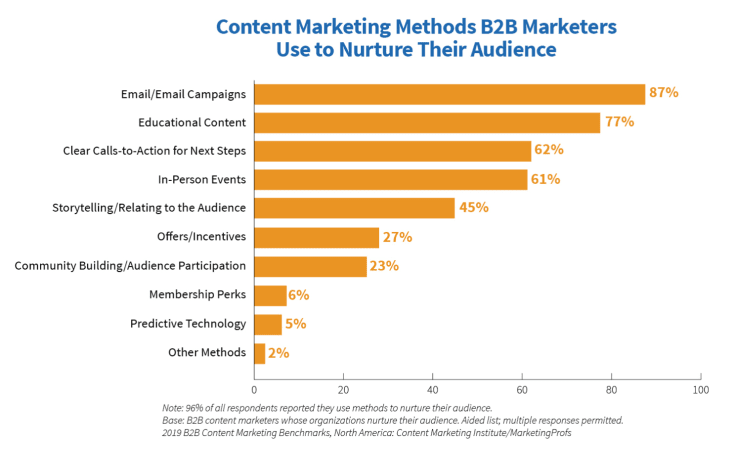
Do you remember when I said that you should extend your thinking beyond online customer engagement? Some brands, especially large ones like Philips, use conferences or trade shows as a way to engage with their prospective buyers. It gives them an opportunity to demo their products and to build a relationship with prospects, which improves their chances of closing a sale.

Acquire
You’ve got hundreds of prospects and leads. Well done. Now comes the hard part: turning them into customers. The acquisition stage is a crucial component of every customer engagement plan. One of the customer engagement strategies you can use is incorporating LiveChat on your website. Not only will you be able to track who is browsing your website, but you’ll also see what page they’re on.
Are you thinking what I am thinking? Imagine a scenario where they land on your pricing page. The chances are good that they’re ready to buy. This gives you an opportunity to engage in a conversation and turn your visitor into a customer. Ka-ching!
Personalized demo calls are another client engagement strategy. They let you address your prospects’ fears, show how your product helps them reach their goals, answer their questions, and build a better relationship with them.
After a demo call, it’s often necessary to send follow-ups that include any additional product information, case studies, or a custom offer. Written communication plays a crucial role in driving high customer engagement. It must reflect your brand culture. Showing emotions and your brand personality in emails is tricky. Make sure that you maintain consistency in your oral and written communication.
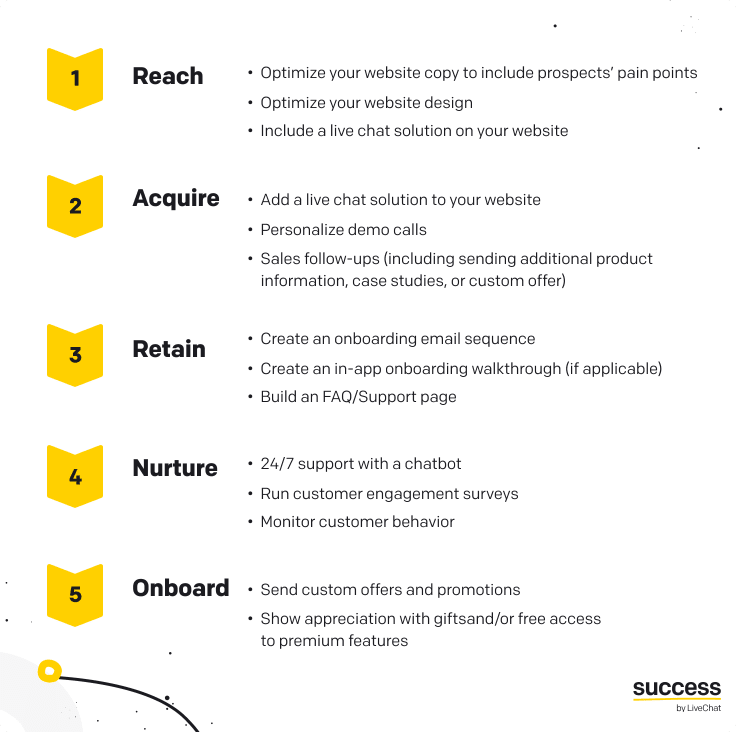
Onboard
Got a new customer? Congratulations! But, before you pop the cork on that champagne bottle, put an effective onboarding strategy in place. I hate to dampen your enthusiasm, but in the U.S., 25% of apps are only used once. Your customer needs to feel comfortable with your product from day one.
If your business has an online presence, a blend of personal communication and automation will go a long way. Start off by creating an onboarding email sequence. Include educational materials like video tutorials, step-by-step instructions, and useful links. What topics should you focus on? Inspire yourself with the questions new customers have asked in the past. Also, take a look at the steps defined in your customer journeys. I also recommend adding contact details to your customer support team or the account manager in each email.
Alternatively, once your onboarding sequence ends, consider sending a follow-up message. Offer your new clients a phone call or chat with a support agent. At the end of the day, it’s always better to ask and predict potential questions than to leave them unanswered.
Now, what if you offer a digital product like SaaS software and your customer must learn how to use it? Create an in-app onboarding strategy. Here’s where your product and design teams will need to work with customer-facing teams on the right user flow. The goal is to create a sequence that explains all your customers need to know to use your product with confidence.
PRO TIP New customers often turn to your FAQ or support page. Use your live chat solution to trigger a pop-up question. For example, ask them whether they found the answer they were looking for or if they want to chat with an agent.
Retain
Now that your customers know how to use your product, you need to keep them invested, both financially and emotionally, in your brand. For this to happen, stay in touch with your customers and watch their satisfaction levels.
For starters, introduce a solution that will support your customers around the clock. While it’s challenging to maintain a 24/7 support team, you can set up a chatbot that will answer customers’ questions after hours. You can automate workflows for common scenarios by, for example, sending refund forms and thank you responses, or pointing customers to FAQ pages. If your chatbot is incapable of providing answers and the client requests to speak to an agent, they will be able to respond once they’re back to work.
It’s also advisable that you check in with your customers yourself. Send them a friendly message. For example:
“Hi, just wanted to check in and see how using [product] has been working for you so far. Let me know if there’s anything I can help you with!”.
Reach out through the communication channel your users have the highest response rates on. You can send them a follow-up email, schedule a call invite, or generate an automated message in chat.
When should you reach out? Ideally, shortly after the onboarding sequence ends. This will allow you to resolve potential customer concerns before they turn into problems. That being said, you must keep an eye out for any peculiar user behavior such as low app return rates or cart abandonment. Reach out to learn about the reasons behind their behavior and how you can fix these issues.
This brings us to the second point: customer satisfaction surveys. Make a habit of sending your customers a survey in a chat or via email. Consider measuring your brand’s NPS (net promoter score) or CSAT (customer satisfaction score). While measuring NPS will rank your customer loyalty levels between -100 to +100 points, CSAT will give you the overall satisfaction rate on a five-point scale.
On top of assessing satisfaction and loyalty scores, also keep a close eye on customer support evaluations. Companies that fail to track customer support performance lose as much as $62 billion a year in the US alone.
PRO TIP Timing is everything. To boost your survey response rates, send your CSAT, NPS, or customer service surveys right after solving clients’ issues. Ideally, while your support agents are still chatting to customers.
Nurture
How engaged your users are is a good indicator of how likely they are to stay with you or churn. When it comes to customer nurturing, the possibilities are endless. It all comes down to your creativity and, sometimes, your budget. Here is how to engage with customers during the nurturing stage.
Customers like and expect personalization. In fact, 90% of them say that they’re willing to share behavioral data in exchange for a more personalized shopping experience. Take advantage of it. Create custom offers and promotions. Let’s say you have a customer who’s been with you for a year. How about offering them a one-month subscription for free?
You can even go a step further and send them physical gifts to celebrate anniversaries. Who wouldn't appreciate a fat, tasty chocolate cake for their birthday? Yet, if it’s not in line with your brand culture, you can always give them access to some premium product features.
You should direct your nurturing efforts towards all your customers, both the highly engaged and the less engaged ones. If you spot any behavioral changes like, for example, a drop in app usage, investigate it immediately. Fast reactions will keep your customers from churning.
Your role in maintaining high customer engagement
Hopefully, by now, you realize that maintaining high customer engagement is a team sport. Irrespective if you’re in customer support, product, sales, marketing, or management, your work has a direct impact on user engagement. If one department goes against customer engagement standards, the entire company suffers.
For one, imagine that you’re selling a SaaS Product. One of your salespeople promises the client that your tech team will help them set up the solution even though it’s beyond what you offer. It was a decision the employee made on their own without consulting the tech department. I’m sure you can imagine the confusion and disappointment your customer will feel when they find out you can’t deliver on the promise.
Let’s now take a look at the role each department plays in customer engagement.

Sales
We all know what the role of sales is. Turning leads into customers. And, believe me, their role in increasing customer engagement is significant. It’s during the sales call that they find out:
- what prospects expect and what they struggle with.
- what similar solutions the prospect had used before.
- why they want to switch.
For example, your salespeople discover that the client was unhappy with your competition’s customer service. Or, perhaps, poor product performance was to blame. They forward these insights to other teams to come up with a customer engagement plan.
Additionally, in today’s market, sales is about relationship selling. Sales reps act as the face of the company. They build relationships with customers. I bet you’ve heard many stories about how a client decided to stay with a brand because they liked their account manager. I’ve heard that plenty of times. It’s worth noting that selling goes beyond sales calls. It also involves social media, live chat, emails, and even live events. You can use all these touchpoints to drive customer engagement.

Marketing
Have you ever heard the term customer engagement marketing? In case you haven’t, I’ll start with the definition. To put it simply, it’s a marketing strategy that focuses on using personalization at all stages of the sales cycle to turn leads into customers and boost their loyalty.
Consumer engagement marketing is about:
- knowing your target audience, especially their fears and goals.
- effective storytelling. Customers get attached to brands, not products. Marketing should create stories that customers can relate to.
- identifying ways in which brands can best reach their audience and be where their customers are.
- creating educational content that answers the most pressing questions in order to build expertise and brand awareness.
- measuring how effective your marketing efforts are and, based on the results, changing your marketing strategy to respond to customer needs.
The true power of CEM is that it focuses more on the “always on” long-term relationship and value of an individual consumer versus the churn mindset found in campaign and acquisition strategies.
Paul Miser, CEO and Co-Founder at Chinatown Bureau
Paul Miser, CEO and Co-Founder at Chinatown Bureau, summarized what consumer engagement marketing is about.
“The true power of CEM is that it focuses more on the “always on” long-term relationship and value of an individual consumer versus the churn mindset found in campaign and acquisition strategies,” Miser explained. “This focus on the consumer transitions decision-making toward the holistic experience, massively improving the consumer experience strategies a company has enabled.”

Customer support
Right next to salespeople, your customer support team is the face of your business. There’s no doubt about it. Once sales brings in new customers, it’s up to support agents to keep them happy. This means answering all their questions to help solve their issues and concerns. Depending on the product, support agents can even be responsible for pampering clients.
All in all, they do much more than just resolve customer issues. For starters, customer support is responsible for executing your client onboarding. If a customer stops coming back to the product, it’s up to support agents to check in and inspect the problem.
To sum up, think of your customer support team as a jack-of-all-trades or at least company ambassadors. They hear customers out, discuss issues with relevant teams, and go above and beyond to keep customers happy and loyal to your brand.

Product
There are several ways in which your product specialists support customer engagement. Among others, they are responsible for:
Fixing errors and bugs
They fix technical issues that cause frustration or make it impossible to use the service. For example, problems with the cart or payment.
Reviewing user requests
The product team collects user insights provided to them by customer support. These include ideas for new products and features as well as integrations. The product team needs to understand the business importance of implementing user ideas. The product owner/product manager reviews the requests to decide how the idea will impact customer engagement.
Researching and optimizing the UX
UX research and design are another important client engagement factor. Your product specialists evaluate customer engagement and UX-related metrics. Based on their findings, they come up with ideas to improve products. Sometimes, product teams also engage in client communication. That’s especially true if support agents lack the technical expertise, which might happen at smaller companies.
Management
While management rarely communicates with customers, at least at big businesses, they play a greater customer engagement role than it seems. How so? It’s simple. Employees look up to management, regardless of whether the C-suite is close with the rest of the team. If the staff sees that management “gets” what the whole customer engagement game is about and focuses on it, they themselves will also feel invested.
Smart leaders regularly communicate with customer support, marketing, product, and sales teams to understand the current engagement levels. They take on risks in a trial-and-error approach. This can mean:
- reworking the pricing model.
- investing in an interface or branding redesign.
- rolling out a feature customers have been asking for.
They understand that customer engagement strategies are never finished and that you must update them.
To sum up, management needs to set the pace or even serve as role models for the rest of the team.
What customer engagement metrics should you track?
As mentioned earlier, customer engagement begins before the prospect becomes a customer. For this reason, when you measure customer engagement, you need to take a look at various factors and metrics. You should start with marketing initiatives and product usage and go all the way to your customers’ interactions with support agents. To make it easier for you, I’ve decided to split the customer engagement metrics into categories. Let’s start off with marketing initiatives.
Marketing
Conversion rate
Conversion rate is the golden standard that shows the highest level of client engagement. Depending on the touchpoints customers interact with, conversion will mean:
- ebook downloads
- demo signups
- free trial signups
- newsletter signups
For instance, here’s how to calculate the conversion rate for a demo signup:

Click and open rates
Both click and open rates relate to email marketing campaigns. Open rate is the percentage of subscribers who’ve opened your email, and the click rate is the percentage of people who have clicked through to your site.
Bounce rates
Bounce rate is the percentage of visitors who leave your page shortly after visiting it without any interaction like clicking on a link.
Number of comments, shares, and likes
Social media metrics can be misleading. Many marketers focus on the number of post impressions, but that’s a vanity metric. A more reliable alternative is looking at the number of comments, shares, and likes on your posts. They display real-life actions your social media audience takes.
Product
App downloads
App downloads refers to the number of times users downloaded the app within a specific time period. Depending on your product, it can be measured on a daily, weekly, or monthly basis.
App retention
App retention rate is another important customer engagement metric. It’s the percentage of users who keep coming back to your app over a given time period. It can be calculated on a weekly, monthly, or quarterly basis.
Monthly active users
This is the number of users who regularly log into your app and use it.
Churn rate
Churn rate is the least exciting customer engagement metric in this section. It’s the number of customers who have left your company. While you can find many advanced formulas online, the basic way of calculating your churn rate is dividing the number of clients who have churned by the entire number of customers and multiplying it by 100.
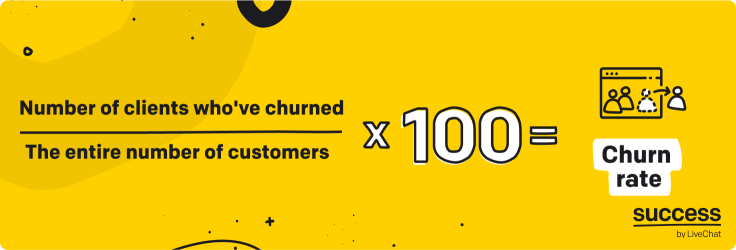
Customer Support
Chat open and response rates
Chat open and response rates are the percentage of customers who have, respectively, opened and responded to a chat message sent out by your customer support. How can you calculate them?
Let’s take a look at an example. You want to find beta testers for your new product feature. Use LiveChat’s targeted messages to send out invitations to chosen users asking if they want to participate. Filter out the customers who opened and responded to your message, divide it by the total number of messages sent, and multiply by 100.
Onboarding email sequence open rates
You calculate your onboarding email sequence open rates exactly the same way as the chat open rate. Take the number of opened emails, divide it by the total number of emails sent, and multiply by 100. Keep in mind that you have to do it individually for each email included in your sequence. That way, you’ll be able to notice any drops in open rates and will know where the engagement issue occurs.
PRO TIP Use Chatbot if you’re worried that a lot of customer engagement data is lost in your conversations with customers. Thanks to natural language processing (NLP), it will analyze large volumes of customer data from multiple touchpoints. As a result, you’ll get access to insights on your customers’ sentiment and engagement levels.
The five biggest mistakes that hurt customer engagement
Creating a customer engagement strategy is a learning process. Often, it’s paved with mistakes and uncertainty. I’ve asked five business experts to share their customer engagement mistakes. Take a look at what they said.
#1 Underestimating the importance of contract renewals

“Here's a mistake I've seen in my career that has created a disconnect between customer and brand.
“It was the lack of engagement when contracts come around for renewal. When increasing customer retention rates by 5% leads to a 25-95% profit increase, one would think there would be a greater focus on keeping customers around. Yet, clearly, this is not the case. This is a missed revenue opportunity that can be easily solved by merging experience marketing with digital renewal campaigns. Doing so will improve brand recall with disconnected customers and make a connection that can't be achieved online”.

Richie Pusateri, Content Manager at Postal.io
#2 Making sales all about quantity rather than quality
“One common mistake that hurts customer engagement is focusing on quantity over quality.
“Sales performance is primarily driven by quota. Sales spend less of their time researching about the customer, and this affects the quality they provide during their sales call. This behavior is the cause of a drop in our site traffic, which leads to less conversion of sales.
“In this age of customer engagement, it’s time to look at leads as more than just numbers. It’s also time to move from static scripts to more dynamic interactions that customers can better relate to. Customers engage more if it is personalized. Sales with real-time customer insights are empowering to provide game-changing customer engagements”.

Robert Johnson, Founder at Sawinery
#3 Trying to convert visitors too early in the game

“One of the worst customer engagement mistakes I've ever made came when I added a pop-up form to my blog in an attempt to woo more email subscribers. While pop-ups can be effective, mine made every mistake in the book. It appeared too early and annoyed my readers, asked them to do something for me, i.e., “sign up for my emails,", instead of offering value to them, i.e., "get a free report." It also alienated more people than it attracted, increasing my bounce rate by 9%. Even worse, the plugin I used slowed my site down which negatively affected my Google SERP rankings and caused my organic traffic to drop by about 15%!” Dave Bowden, Founder at Irreverent Gent

Dave Bowden, Founder at Irreverent Gent
#4 Removing the customer service phone number from the web
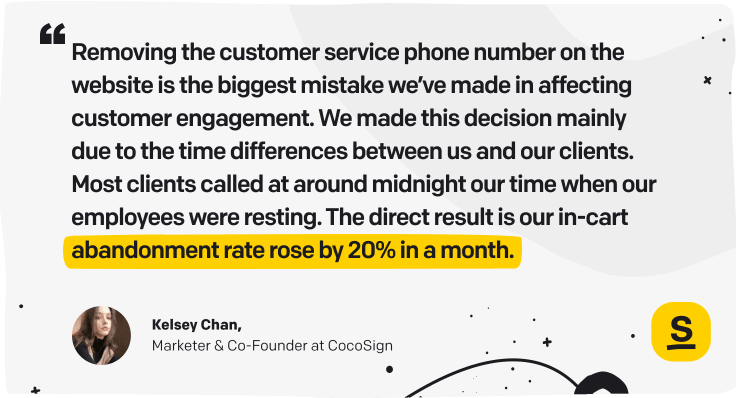
“Removing the customer service phone number on the website is the biggest mistake we’ve made in affecting customer engagement. We made this decision mainly due to the time differences between us and our clients. Most clients called at around midnight our time when our employees were resting.
"The direct result is our in-cart abandonment rate rose by 20% in a month. My guess is that when customers meet issues in purchasing, they tend to expect direct responses instead of leaving a message and waiting for a reply within 48 hours. Otherwise, it’s quite easy for them to go to other sites with quicker customer support.
"We addressed the issue by adding a chatbox on our site and set up automatic replies for most basic questions. We have also put our customer support team’s Skype accounts there for the customers to add. They may have to wait for the reply for some time, but the act of getting connected with the support team is a big relief already.”

Kelsey Chan, Growth Marketer & Co-Founder at CocoSign
#5 Unpolished onboarding experience
“The onboarding experience, as a whole, is always a steep learning curve. The sales team makes the promises, and onboarding has to keep them. We learned quickly that "onboarding" on its own is meaningless unless we could prove we're in a place to fulfill our promises. We didn't notice churn because of our lack of proper onboarding as much as we saw a reduction when we dove into it.
“We had an initial problem with an onboarding system. It needed to be structured. Since it wasn't, people were falling through the cracks. We adjusted to being proactive with drip campaigns and scheduled meetings. It keeps the customers excited about the product and engaged until they can be self-sufficient”.

Frank DiPatri, Chief Communication Officer at Shamrock Software
How can you improve customer engagement?

Customer engagement is more than a task you tick off your to-do list. It’s a long-term commitment. As your customer base and product change over time, so must your approach to retaining users. Your customer engagement strategy needs to align with your company’s goals and the products you offer. Below is a blueprint you can use as a starting point.
1. List all your customer interactions
List all online and offline touchpoints where your users and prospects interact with your brand. Start off with the communication channels where you engage with customers the most. For example, chat and email. Next, consider the places where you reach them passively. This includes your website copy, blog content, or even billboards. To ensure that you’ve listed all the touchpoints, ask your product, marketing, customer support, and sales teams to contribute.
2. Agree on the metrics and standards
Select the customer engagement metrics that fit your interaction channels. For instance, if you want to measure customer involvement within the product, you can turn to monthly active users or evaluate the churn rate. For an overview of client engagement metrics, refer to the previous section of this guide.
Discuss the right engagement standards with your team. For example, you can agree that you want to keep your churn rates under X%. Reconsider this threshold after a given period. The goal is to constantly motivate your team to improve your client engagement rates.
3. Gather the data
After defining customer metrics and standards, you’ll need to collect relevant data. It’s impossible without using the right customer engagement tools. If you want to learn about your customers’ on-site behavior, you can turn to Google Analytics. The same goes for measuring a metric related to customer communication. You can dig into the data and statistics in LiveChat. The more tools you use, the more complicated this process gets. Think of a way to present the most important data on a single dashboard. I recommend giving Google Studio a try.
4. Analyze the data and draw conclusions
After you’ve collected all the relevant data, it’s time to analyze it. Compare your findings against the standards you’ve set and spot any patterns. For example, you’ve noticed the ebook download rates on your website went down in the past month. After some research, you realize that you’ve recently made it impossible to download with a @gmail.com address. This leads us to the next point, and that’s an improvement plan.
5. Create a customer engagement improvement plan
Let’s continue with the example from the previous point. Once you know that blocking ebook downloads from Gmail hurts your conversion rate, you can disable the validation rule. This is just one example, and you should follow the same steps for all the problems you identify.
Make sure to put your customer engagement improvements in writing. You can create an after action review (AAR) that mentions:
- the issue you identified.
- the reasons behind it.
- the actions you’ve taken to fix the problem.
Remember to assign an owner to each improvement initiative so that the team feels accountable.
6. Measure the results continuously
Revisit your customer engagement strategy on an ongoing basis. Depending on your product and industry, decide whether it’s best to evaluate customer engagement levels on a monthly or quarterly basis. The key is to do it regularly and introduce the required improvements on time.
Customer engagement tools worth using
I’ve covered several customer engagement ideas and strategies. It’s now time to look at the types of tools you can use.
Let’s start off with the solutions you can set up on your website.
Website analytics
Your website is often the first point of interaction a customer has with your product. That’s why it’s worth deriving insights on user behavior.
For starters, set up a Google Analytics account for your website to understand user behavior. You can also use Piwik PRO as a self-hosted alternative to Google’s cloud solution. Such tools allow you to track, among other metrics:
- conversion and bounce rate per each page.
- your users’ demographics and behavioral patterns.
- average session duration per page.
- user acquisition channels like organic search, social media, or referrals.
- the number of new and returning visitors.
Secondly, I recommend supplementing website analytics with session recording tools. They’ll give you more than just hard, numerical data. Tools like Hotjar, LiveSession, and FullStory will show you how users move around and interact with the interface. Importantly, you can see the scroll depth rates for each page and see what elements users click the most on. You’ll be surprised with the variety of information you can collect from watching website recordings.
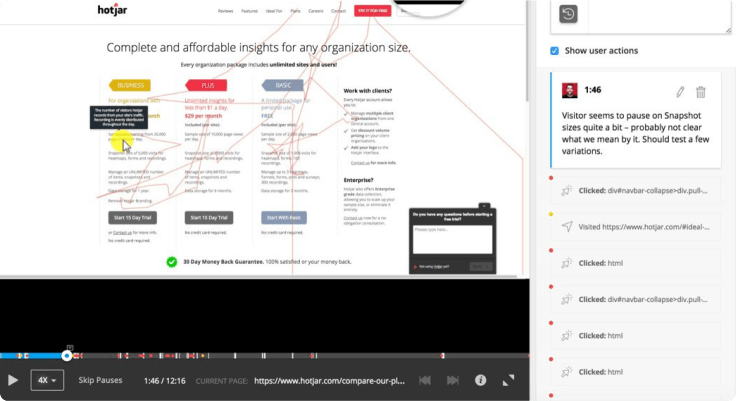
Based on the insights from the above tools, you can come up with ideas for improvement. Run A/B tests on your website. Verify your hypotheses using Google Optimize or Optimizely and choose the better-performing option.
Social media networks
Just like organic search, social media can serve as the first channel where prospects learn about you. Imagine a scenario where someone on Facebook asks for recommendations of products similar to yours. In one of the comments, a user mentions your brand. It’s the perfect moment to reach out and start a conversation to turn the prospect into a lead.
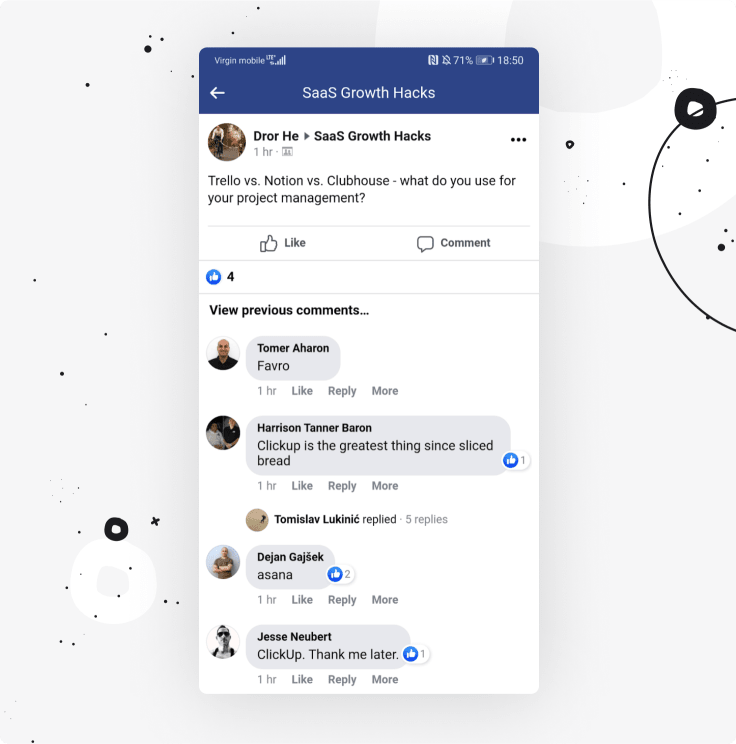
In the current market, social media goes beyond chatting and is an efficient sales tool. I discuss this subject in more detail below.
Live chat solution
Live chat is a powerful tool that gives you more options than responding to customer queries and solving their problems. It’s often used to close deals and maintain customer interest.
LiveChat is a complete customer service platform. It helps you handle communication with customers and leads across various digital channels. Apart from your website chat, it also includes conversations from various platforms including:
- Messenger
- Apple Business Chat
- SMS
Keeping your entire communication under the same roof makes it easier to spot hot leads. You can send over discount codes, links to products, and let customers pay, all within LiveChat.
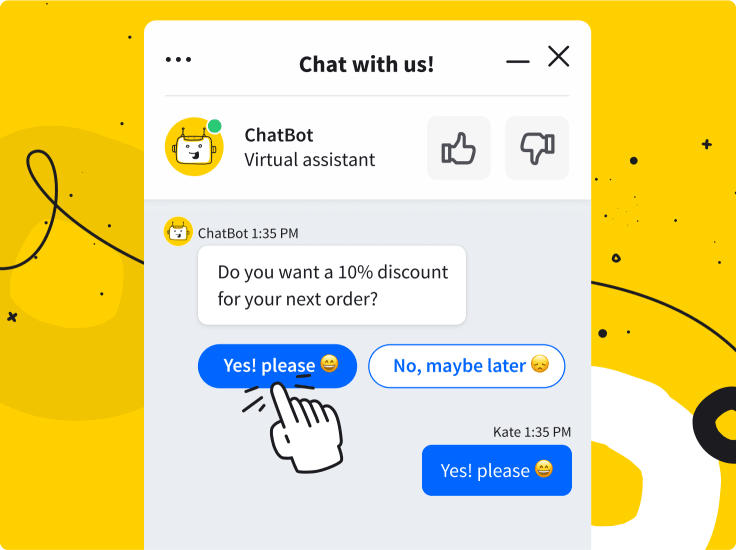
If you sell enterprise solutions and your sales cycle is long, you can use LiveChat to schedule a demo meeting and shorten the path to conversion.
Customer survey tools
On top of the tools discussed above, I also recommend that you use a survey solution. If you’re thinking that you can use customer surveys to measure satisfaction levels, you’re right. On top of that, you can also use them to collect ideas on how you can improve your engagement strategy.
Think about it. When you ask customers for their tips and ideas, you’re already taking the first step towards increasing their engagement. It proves your dedication to improving customer experience.
As a person involved in product development, it’s very hard for you to fully step into your customers’ shoes. You lack objectivity. That said, take your clients’ suggestions into account. It will save you time and money.
The best customer engagement examples to use as inspiration
Ready to get started with your customer engagement strategy? Luckily, there are many brands you can draw inspiration from.
LiveChat trains all its employees in customer support

Businesses that exceed at driving customer engagement show high levels of empathy. It’s not something you can take a crash course on because you have to learn it through practice. As LiveChat grew, they realized that the best way to know the customers and product inside out was through training everyone in customer support.
We don’t want to have people on board who don’t know what we do
Piotr Bednarek, COO at LiveChat
“We don’t want to have people on board who don’t know what we do,” says LiveChat COO, Piotr Bednarek. “At a certain point, we had employees who didn't know what we did. They didn't know who our customers were. They didn't know what our products do. They were focused on fulfilling the responsibilities of their job title, but not thinking, ‘Hey, there's someone who's going to use it!”
For LiveChat, it’s clear that the entire company is responsible for customer engagement, leadership included. In fact, many of their leaders started off in customer support since the company sees it as a natural starting point for their careers.
To drive high customer engagement, your team must empathize with customers. They also need to have extensive product knowledge to handle any client questions.
Trader Joe’s sells almost exclusively under their own label
The famous U.S. discount store is another good example of customer engagement. The retail chain regularly tops the American Customer Satisfaction Index Chart (ACSI), right next to brands like Amazon and Costco.
The company turned the rather mundane grocery shopping chore into an enjoyable experience. They don’t offer special deals, coupons, or rewards to keep their customers engaged. Instead, they win the hearts of customers by making the grocery experience fun.

As far as product labeling goes, Trader Joe's does two things at the same time. They offer almost exclusively white-labeled items that feature their brand name. This way, they’re able to eliminate the so-called “paradox of choice” and keep their shopping experience simple. Next, they ensure that customers interact with their brand every time they open their refrigerator or reach into their pantry. This prolongs brand exposure and drives attachment.
Buffer keeps its support agents happy to drive client engagement
Buffer realizes that employee engagement and customer engagement are related. That said, they also know that the competition for support agents in tech is fierce.
To win the best talent, Buffer goes above and beyond to offer candidates unique benefits. Among others, their employees receive:
- at least three weeks of paid leave each year.
- a conference budget.
- $5,000 per employee on company retreats.
- U.S. healthcare coverage, 100% for employees and 50% for their dependents.
- extra premiums for each dependent like, for example, children/spouse/partner of $3000/year.
The founders know that morale and job stability impact their employees’ work quality. Their support agents bring a lot of joy and positivity into the workplace, which is also felt by customers.
Amazon anticipates customer needs
Amazon’s approach to making its customers’ lives easier is a great customer engagement example. Despite becoming one of the world’s biggest companies, it has never lost sight of customers. According to Amazon’s Customer Service Tenets, one of their customer support pillars is to “anticipate customer needs and treat their time and attention as sacred.”
A good example is how they handle problems with video download speed. Amazon issues automatic refunds if they detect low data transfer quality. Most companies lack proactivity and require customers to report issues. This often means that clients spend time waiting for someone to answer their call or respond on chat. Amazon is aware that such an approach will pay off and boost customer loyalty.
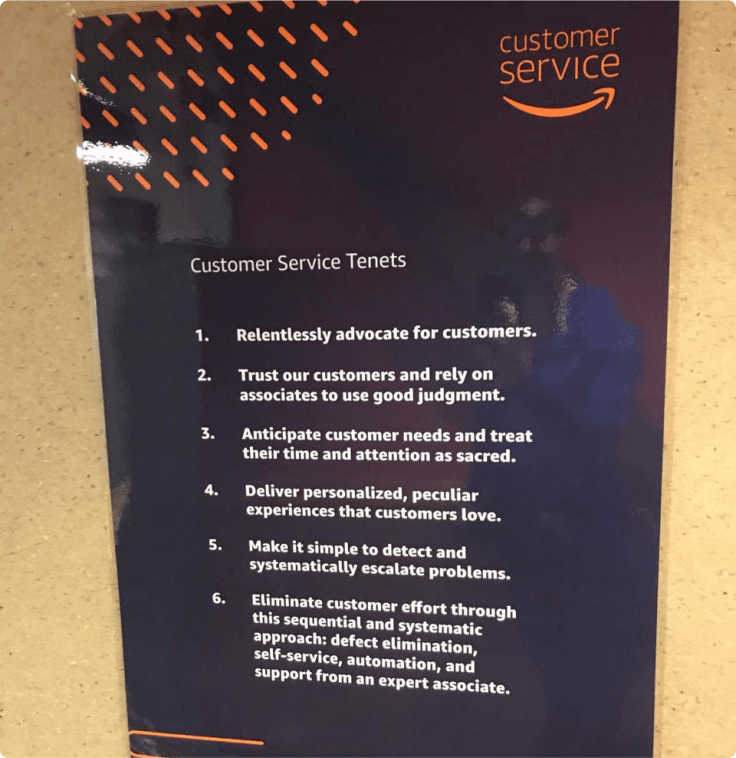
Driving high customer engagement: key takeaways
As it is in life, all good things must come to an end. So must this guide! To make sure what you’ve learned sticks, let’s summarize the main takeaways.
The term customer engagement might be misleading because it sounds as if it only revolves around clients. In reality, though, it starts well before you can call someone your customer. By the time someone signs up or places their first order, your marketing and sales teams have already put in the effort to attract and convince them to buy. That’s when your customer support agents step in and take over by onboarding new clients and maintaining their satisfaction. They work hand in hand with your product team to make sure you’re always offering the best user experience and value for the money.
If you want to make client engagement a long-term commitment, create a customer engagement strategy. Remember to list all your user interactions based on the customer journey and to choose the right metrics to measure them. Assign a standard to each customer engagement metric and revisit your strategy regularly to check if it’s working.
Since driving high customer engagement is a team sport, share this guide with other teams. I am sure it will come in handy as you discuss the new ways to keep your clients happy and invested for longer.
Good luck, and let me know how it goes!
Get a glimpse into the future of business communication with digital natives.
Get the FREE report




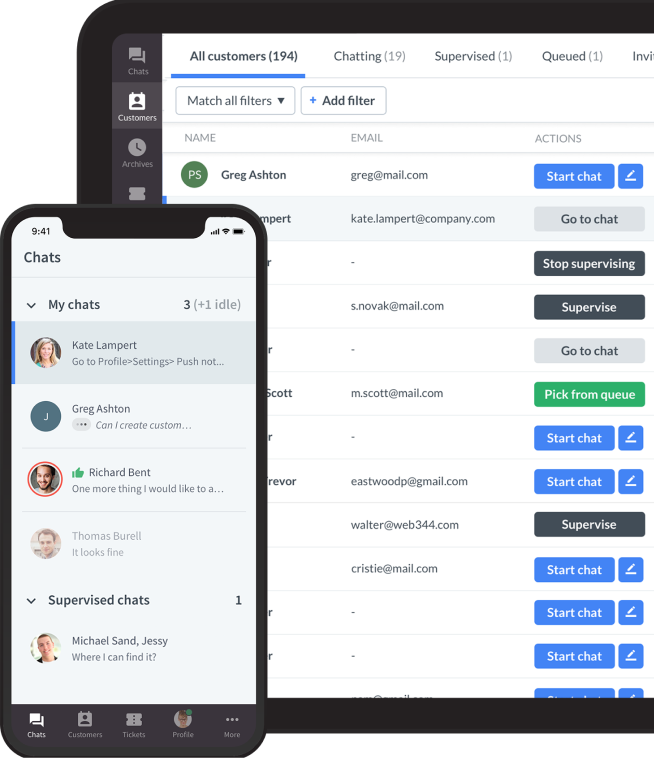



Comments